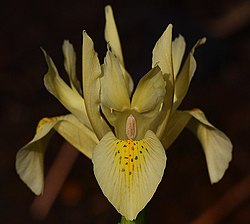Top Qs
Timeline
Chat
Perspective
Iris winogradowii
Species of flowering plant From Wikipedia, the free encyclopedia
Remove ads
Iris winogradowii is a species of flowering plant in the genus Iris, classified in the subgenus Hermodactyloides and section Reticulatae. It is a bulbous perennial, from the Caucasus mountains of Azerbaijan and Georgia.
Remove ads
Description
It has pale primrose yellow flowers,[2] with green spots on the falls,[3] the scented flowers are up 5 cm tall and emerge between April and May.[4] With stem and flower the plant reaches a height of 10–15 cm.[3] The leaves emerge after flowering and grow up to 30–40 cm.[4] It has between 2–4 leaves each growing season.[5]
Taxonomy
It is sometimes known from the common name of Wingradoff's iris.[2]
It was named after P.Z. Winogradow-Nikitin who first described it.[4]
It was first found in 1914 and then published and described by Aleksandr Vasiljevich Fomin in 'Schedule Herb Flora Caucasus'. Vol.4 on page 88 in 1914.[6][7]
An illustration was seen in 1961 in the 'Collins Guide to Bulbs'.[8] It was grown in Australia from seed provided by the Komarov Botanical Institute in St. Petersburg in 1972.[9]
It was verified by United States Department of Agriculture and the Agricultural Research Service on 4 April 2003, then updated on 1 December 2004.[7]
Iris winogradowii is an accepted name by the RHS.[10] The iris later gained the RHS's Award of Garden Merit.[11]
Remove ads
Distribution and habitat
It is native to temperate Asia.[7]
Range
It is found in Azerbaijan and Georgia.[7]
In 1972, Dr Rodionenko noted that several hundred iris plants were on Mount Lomtismta near Bakuriani, (in Georgia).[12]
Habitat
In 1914, it was originally found in the gravelly soils of the alpine meadows of Mount Lomtismta. Part of the Caucasus regions of Adzharo-Imeretinskiy Range.[13]
Conservation
The plant is now on the 'endangered' list. Now only found in the republics of Georgia and Abkhazia.[9][14] Only a couple of hundred plants existed in 1978.[5] In the Caucasus mountains, it is at risk of extinction due to the over-collection of the flowers and bulbs.[15]
Cultivation
It was first grown in the UK in 1923.[4]
Due to its alpine origins, it prefers to grow in semi-shade in cool peat enriched soils.[16]
It is normally grown in a rock garden, alpine house or bulb frame.[5] In gardens it prefers humus-rich, porous soil in cool shade and does best if replanted each year after a fairly dry summer.
It has been remarked that this species is difficult to grow in a pot.[3]
Remove ads
Cultivars

In 1960, E.B. Anderson created the hybrid of Iris histrioides and Iris winogradowii. He then named the plant after the wife of a fellow enthusiast, Eliot Hodgkin (mother of Sir Gordon Howard Eliot Hodgkin).[3] Iris Katharine Hodgkin has light blue standards and pale yellow falls.[17]
Iris 'Sheila Ann Germaney' is another hybrid between Iris histrioides and Iris winogradowii. It is similar to 'Katherine Hodgkin', with a paler blue tone and less yellow colouring.[3]
Iris 'Frank Elder' is a white form hybrid.[2]
Remove ads
References
Other sources
External links
Wikiwand - on
Seamless Wikipedia browsing. On steroids.
Remove ads

